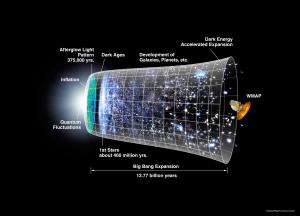Blog
The Shape of Things
15 January 2014
 NASA/WMAP Science Team
NASA/WMAP Science TeamThe most widely accepted model for the universe, sometimes called the standard model of cosmology, is known as the ΛCDM model. The Λ or “lambda” refers to the dark energy parameter known as the cosmological constant (which often uses lambda to represent its value). The CDM stands for Cold Dark Matter, which is the type of dark matter currently best supported by observation. In the ΛCDM model, the matter of the universe consists of regular matter (about 5%), cold dark matter (about 27%). Dark energy is then caused by a cosmological constant, which is a property of space and time itself, giving rise to dark energy.
There is a lot of observational evidence to support the ΛCDM model, such as the cosmic microwave background and the redshift-distance relation known as Hubble’s law. But often when we look at observational data we assume the model is true in order to analyze other aspects of the universe. In other words, our results are model dependent. If it turns out the universe actually follows a different model, then our results could be skewed.
So is there a way to test whether the ΛCDM model is accurate for our universe, or if some other model might work as well. It turns out that there is, and it’s known as the Alcock-Paczynski cosmological test. The basic idea of this test is to measure two things: the redshift of an object (for which we typically use the ΛCDM model to determine its distance) and the apparent size of the object. Since any model for the structure of the universe will predict a relation between these two quantities, you can use these quantities to test the accuracy of your model.
A recent paper in the Astrophysical Journal has done just that.1 Using redshift and apparent size data for distant galaxies, the authors test six models that represent a wide range of possibilities: ΛCDM, Einstein-de Sitter (a model with no dark matter), Friedman model (no dark energy), quasi-steady state cosmology (no big bang), a static universe model, and static universe with “tired light.”
What the authors found was that only two models agreed with the Alcock-Paczynski test, the ΛCDM model and the tired light model. What makes this interesting is that the Alcock-Paczynski test doesn’t make any assumptions about the structure of the universe. It doesn’t assume the existence of dark matter, dark energy or anything else. Based on this test alone we either live in an expanding universe with dark matter and dark energy that began with a big bang, or we live in a static universe where the redshift of galaxies is due to the spontaneous redshift of “tired light.” The other models are excluded with a confidence of more than 95%.
It’s interesting that the tired light model passes this test, but this model contradicted by other observational evidence. If we lived in a static tired-light universe, distant galaxies should appear blurred (they don’t), distant supernovae shouldn’t be time-dilated by cosmic expansion (they are), and we shouldn’t see a cosmic microwave background (we do). So we can exclude the tired-light model as well.
So that leaves ΛCDM. That is the universe we live in.
Lopez-Corredoira, Martin. “Alcock-Paczyński cosmological test.” The Astrophysical Journal 781.2 (2014): 96. ↩︎